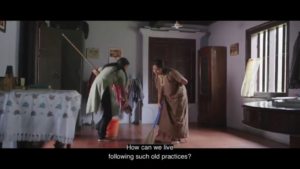In her critique of ‘The Great Indian Kitchen,’ Sruthi Herbert questions the film’s attempt to frame upper caste women’s interests as all women’s interests.
Sruthi Herbert
The Great Indian Kitchen (TGIK) released via an OTT platform on 15 January 2021 has garnered a lot of attention for its portrayal of gender-based violence, particularly domestic violence. Most of these are positive—understandably so, as it captures some nuanced interactions between the wife-husband protagonist duo that are abusive, but often would be brushed aside as inconsequential ‘normal’ tiffs within a family that needs to be privately resolved, not publicly discussed.
However, the movie (quite unintentionally) also offers a peek into another upper-caste anxiety—that the acknowledgement of differences in the experience of gender-based violence across social strata may challenge feminist solidarities. This anxiety is expressed through a short sequence of less than two minutes in duration (between 00:43:20 and 00:45:07). It is then quickly sealed shut through a resolution that is hard to disagree with: that of the sisterhood of all women through their shared experience of household work.
In this sequence, the protagonist (P), a Nair woman, is kept away from household chores due to menstruation taboos. A maid (M) helps her out exclusively on these days. M sympathises with P because P’s house is big and sweeping and mopping it is backbreaking labour. ‘I am lucky’, she says, ‘my house has only two rooms and a tiny kitchen’. She paints herself as liberated, not bound by the oppressive customs and practices that are part of upper-caste women’s lives. No one bothers if she is menstruating or not, she says — the denial of her experiences of womanhood (and by extension, her exclusion from discussions of reproductive health) is a good thing. Just as her poverty is, and having to work in one of the most underpaid jobs is! And through this luck, there is scope for solidarity between P and M, especially because the lower-caste poor woman herself says she is empowered and extends sympathy to the upper-caste woman. Through the movie, the audience finds themselves extending empathy to the upper-caste Nair women as the greater victim of gender-based violence.



The invisibility of women’s household labour and care work is a powerful motif within articulations for women’s equality. When deployed within the movie, it falls short of taking cognisance of the extremely different circumstances of these two women—for instance, while the protagonist is involved in unpaid household labour in her own home, the maid is involved in (grossly under-)paid household work in the house of her social superiors. These are two separate issues which, for the sake of convenience, the movie melds into one.
However, this short sequence does accomplish one thing: a curious (and rather disingenuous) inversion where the maid is the empowered woman and the upper-caste lady of the house is more disempowered. This casting of some of the most empowered women such as P—women whose basic needs of food, shelter and clothing are invariably met, who have access to resources such as education and money, and who enjoy the possibility of acquiring paid employment when they decide that they want it—as the true victims of gender-based violence has resonances with the ‘missing white woman syndrome.’ In Western countries, it has been pointed out that missing upper-middle-class white girls/women victims with characteristics deemed ‘attractive’ receive disproportionately high media coverage while other categories of missing girls/women victims are less valuable/more disposable. These moments in TGIK thus erase the daily violence of caste and class experienced by the maid, refocusing on the victimhood of the upper-caste woman within her own home, as subject to an insidious form of violence (no doubt) that needs prioritising. This victimhood merely reinforces the framing of upper-caste women’s interests as all women’s interests. The labour of reframing this falls on Bahujan women.
About the Author: Dr Sruthi Herbert has a PhD in Development Studies from SOAS University of London. She is interested in understanding society from the vantage point of the excluded.

Utter nonsense. As a Dalit woman who works with women you describe as “paints herself as liberated” for many years, I can tell you this purely academic imagination on your part. Who is a liberated woman? The one academics like you see as one or the one who feels and lives as though she’s liberated? You very conveniently forget what the maid says about her menstruation — that she doesn’t even tell her employers sometimes that she’s on her period and continues working. It might be because she needs the work, sure, but is that just it? Unpack the layers there before you sit in your academic ivory tower and build walls and victimhoods that don’t exist. At least in this film.
To your point about the disparity in their situation — one works unpaid in her own home, the other in someone’s home albeit underpaid. What’s your point here? I see that you skipped elaborating here. Once more, sleight of hand on your part.
The scene merely goes on to show the impact of Brahminical notions of purity and it’s impact on upper caste women. It has been well documented how Bahujan and Dalit households once they achieve social and economic mobility also take on the same discriminative practices. The maid here is expressing what we already know, that regressive practices that disempower women are based on false notions of family honour, need for continuation of endogamy and puritanism. The maid being from a household that values her income is allowed to let go of these practices. It’s easy to mistake it for liberation. We have all been there. The overall theme is still the control exercised by a paricharchal society on women and how it impacts different women differently. Effortless or not, Female solidarity is our only source of hope. Completely disagree with the missing white woman analogy used here.